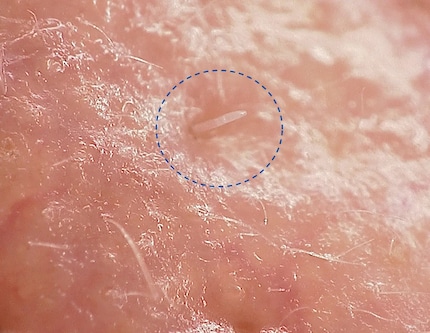
At night our face becomes the reproduction area
Our face is full of little roommates: According to a study, hair follicle mites could soon enter into a permanent existence with and within us. Their genome has already been significantly reduced.
The thought of it will certainly not cheer up many people very much. But our face and nipples are the habitat for countless tiny eight-legged creatures that have made themselves at home there in the hair follicles: Hair follicle mites (Demodex folliculorum) are so closely intertwined with us that they could be on their way from parasite to true symbiont. This is suggested by a study by Alejandro Manzano Marín of the University of Vienna and his team in Molecular Biology and Evolution.
The research group had analyzed and sequenced the genome of the eight-legged creatures. The result: the mites, which are only 0.3 millimeters in size, have abolished more and more genes and also cells over time as a result of inbreeding and isolation on our bodies and have thus evolved into an organism that is already significantly reduced. "They survive with a minimal repertoire of proteins - the lowest number ever observed in this and related species," says Manzano Marín.
Hair follicle mites feed on sebum secreted by hair cells in the pores. They are especially active at night; that's when they move between follicles looking for mating partners. However, they cannot survive permanently outside the pores. The study also discovered a reason for the nocturnal activity: Among other things, the microorganisms have lost their UV protection gene and the so-called timeless gene, which is responsible for waking up other creatures during daylight. Instead, they are awakened by melatonin, which is secreted by us at night.

Manzano Marín and Co. also refute the assumption that mites do not have an anus. According to this, their body would fill with feces during their short life. If they then died, it would be released, which could lead to skin irritations. In fact, however, the animals have an excretory organ and regularly release their digestive products. In this way, they may even ensure that the skin pores become clogged less frequently.
Unique among mites is also the reproduction of the species: The penis of the males protrudes forward upwards, which means that they have to position themselves under the female during mating and both hold on to human hairs during this time. However, they always mate with each other in the same population, so genetic refreshment rarely if ever occurs in the genome. "Inbreeding results in an accumulation of deleterious mutations, and bad gene variants eventually spread rapidly," says Manzano Marín. "This evolutionary pathway has already been observed in bacteria living in cells, but has not yet been clearly demonstrated in an animal." The mites' path could therefore lead not only to a true symbiosis, but equally to an evolutionary dead end with fatal consequences: The species could then become extinct.
Spectrum of Science
We are partner of Spektrum der Wissenschaft and want to make well-founded information more accessible to you. Follow Spektrum der Wissenschaft if you like the articles.
Originalartikel auf Spektrum.deTitelbild: © Henadzi Pechan / Getty Images / iStock (Ausschnitt)
Experts from science and research report on the latest findings in their fields – competent, authentic and comprehensible.